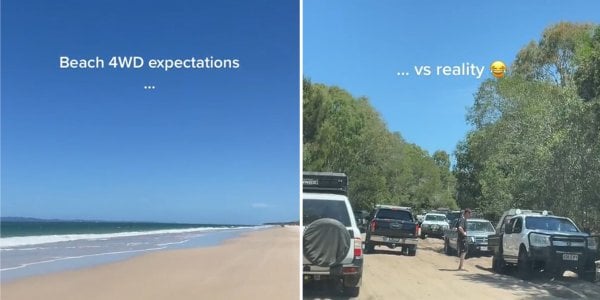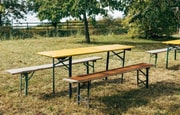Beach bummer: Bribie Island's 4WD fiasco unearths tyre pressures pitfall
- Replies 1
Australia's coastlines are a treasure trove of natural beauty, with Bribie Island in Queensland standing out as a prime example.
Its stunning beaches and idyllic camping spots draw tourists and locals alike, eager to experience the quintessential Aussie beach adventure.
However, a snag in this picture-perfect setting catches many off guard, especially those new to the 4WD beach scene.
Rick Williams, a local towing service owner with 14 years under his belt, has seen it all.
He's the go-to rescuer for many travellers who find themselves stuck in the sand, their vehicles bogged down before they even reach the beach.
This common blunder is often a rude awakening for visitors, particularly those from overseas, who are lured by the flawless images on social media depicting a flat, sandy paradise.

Sophie, a recent visitor to Bribie Island, took to social media to share the stark contrast between expectation and reality.
Her video showcased the dreamy beach vistas labelled 'expectations' before cutting to the 'reality' of a congested 2km access road, with vehicles hopelessly bogged in the soft sand.
Williams confirmed that this scenario is all too common, especially on weekends, and pinpointed the critical error most people make.
The mistake? Tyre pressure.
‘You've got people who are novices who don't know about four-wheel-driving, they try and drive up the beach and go through there with 40 PSI in their tyres,’ Williams pointed out.
‘They should be dropping it right down to about 18psi.’
‘When you drop the tyre pressure down, it flattens the bottom of the tyre so you can roll across of the sand rather than ploughing your way through it,’ he continued.
However, tyre pressure isn't the only issue.
Williams observed many drivers attempting the sandy track in vehicles that weren't 4WDs.
According to Williams, this often leads to a domino effect of bogging incidents as shown in Sophie’s video.
‘A person gets bogged and then someone else will come along and say, “I can get you out.” Then bang, they'll get bogged,’ he explained.
‘Then someone will come along and say, “Oh, I'm not waiting on these guys”, and then they try to go around and they get bogged. So unless you really know what you're doing, you're not getting through.’
Signage along the access road clearly states that only 4WD vehicles are permitted, yet some visitors either ignore the warnings or are unaware of their vehicle's capabilities.
Williams recounted an incident involving two British tourists who, led astray by Google Maps, found themselves bogged with a rental they didn't know how to handle.
He remarked that frequently, individuals have ‘no idea what they're driving’, or whether it's appropriate for off-road conditions.
‘They don't know, so they think they can and they just go,’ he said.
Commenters on Sophie's video echoed Williams' advice about the tyres.
‘Good ole Bribie and the 40 PSI club,’ one commenter said.
‘Deflate your tyres and you could do it in 2WD,’ another advised.
‘Nearly every day is like this,’ a third agreed.
As beachfront destinations continue to attract visitors, it's crucial to be aware of the common mistakes made by those navigating these scenic landscapes, especially when it comes to driving on the sand.
These recent incidents highlighted by Williams shed light on the risks associated with improper vehicle usage in such environments.
Meanwhile, discussions about potential access fees for beachgoers in another Aussie beach are stirring within the community, prompting concerns among drivers who frequent these coastal areas.
Understanding the nuances of beach driving and staying informed about proposed changes to access policies are essential for both safety and preserving the enjoyment of these natural wonders.

Have you had any bizarre beach driving experiences that you'd like to share? Do you have other tips on how to avoid getting bogged in the sand? We'd love to hear how you navigated the sandy shores in the comments below!
Its stunning beaches and idyllic camping spots draw tourists and locals alike, eager to experience the quintessential Aussie beach adventure.
However, a snag in this picture-perfect setting catches many off guard, especially those new to the 4WD beach scene.
Rick Williams, a local towing service owner with 14 years under his belt, has seen it all.
He's the go-to rescuer for many travellers who find themselves stuck in the sand, their vehicles bogged down before they even reach the beach.
This common blunder is often a rude awakening for visitors, particularly those from overseas, who are lured by the flawless images on social media depicting a flat, sandy paradise.

Rick Williams noted a common error among visitors driving on Bribie Island's 4WD beach, resulting in vehicles getting stuck in the sand. Credits: Tiktok / Sophie Hill
Sophie, a recent visitor to Bribie Island, took to social media to share the stark contrast between expectation and reality.
Her video showcased the dreamy beach vistas labelled 'expectations' before cutting to the 'reality' of a congested 2km access road, with vehicles hopelessly bogged in the soft sand.
Williams confirmed that this scenario is all too common, especially on weekends, and pinpointed the critical error most people make.
The mistake? Tyre pressure.
‘You've got people who are novices who don't know about four-wheel-driving, they try and drive up the beach and go through there with 40 PSI in their tyres,’ Williams pointed out.
‘They should be dropping it right down to about 18psi.’
‘When you drop the tyre pressure down, it flattens the bottom of the tyre so you can roll across of the sand rather than ploughing your way through it,’ he continued.
However, tyre pressure isn't the only issue.
Williams observed many drivers attempting the sandy track in vehicles that weren't 4WDs.
According to Williams, this often leads to a domino effect of bogging incidents as shown in Sophie’s video.
‘A person gets bogged and then someone else will come along and say, “I can get you out.” Then bang, they'll get bogged,’ he explained.
‘Then someone will come along and say, “Oh, I'm not waiting on these guys”, and then they try to go around and they get bogged. So unless you really know what you're doing, you're not getting through.’
Signage along the access road clearly states that only 4WD vehicles are permitted, yet some visitors either ignore the warnings or are unaware of their vehicle's capabilities.
Williams recounted an incident involving two British tourists who, led astray by Google Maps, found themselves bogged with a rental they didn't know how to handle.
He remarked that frequently, individuals have ‘no idea what they're driving’, or whether it's appropriate for off-road conditions.
‘They don't know, so they think they can and they just go,’ he said.
Commenters on Sophie's video echoed Williams' advice about the tyres.
‘Good ole Bribie and the 40 PSI club,’ one commenter said.
‘Deflate your tyres and you could do it in 2WD,’ another advised.
‘Nearly every day is like this,’ a third agreed.
As beachfront destinations continue to attract visitors, it's crucial to be aware of the common mistakes made by those navigating these scenic landscapes, especially when it comes to driving on the sand.
These recent incidents highlighted by Williams shed light on the risks associated with improper vehicle usage in such environments.
Meanwhile, discussions about potential access fees for beachgoers in another Aussie beach are stirring within the community, prompting concerns among drivers who frequent these coastal areas.
Understanding the nuances of beach driving and staying informed about proposed changes to access policies are essential for both safety and preserving the enjoyment of these natural wonders.
Key Takeaways
- A local towing service operator, Rick Williams, has observed a common mistake made by visitors driving on Bribie Island's 4WD beach, leading to vehicles getting bogged in the sand.
- The mistake involves visitors not reducing their vehicle's tyre pressure before attempting the sandy track, which causes many to become stuck.
- The issue is worsened by inexperienced drivers or those attempting the track in vehicles that are not suitable for 4WD conditions.
- Despite signage indicating that only 4WD vehicles are allowed on the access road to the beach, many visitors, including international tourists, ignore the warnings or are unaware of the proper vehicle requirements, resulting in frequent towing rescues.







